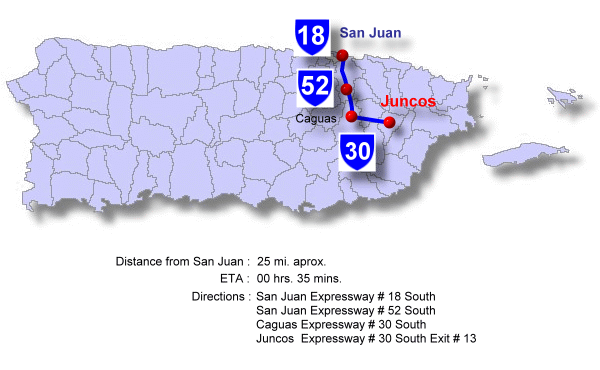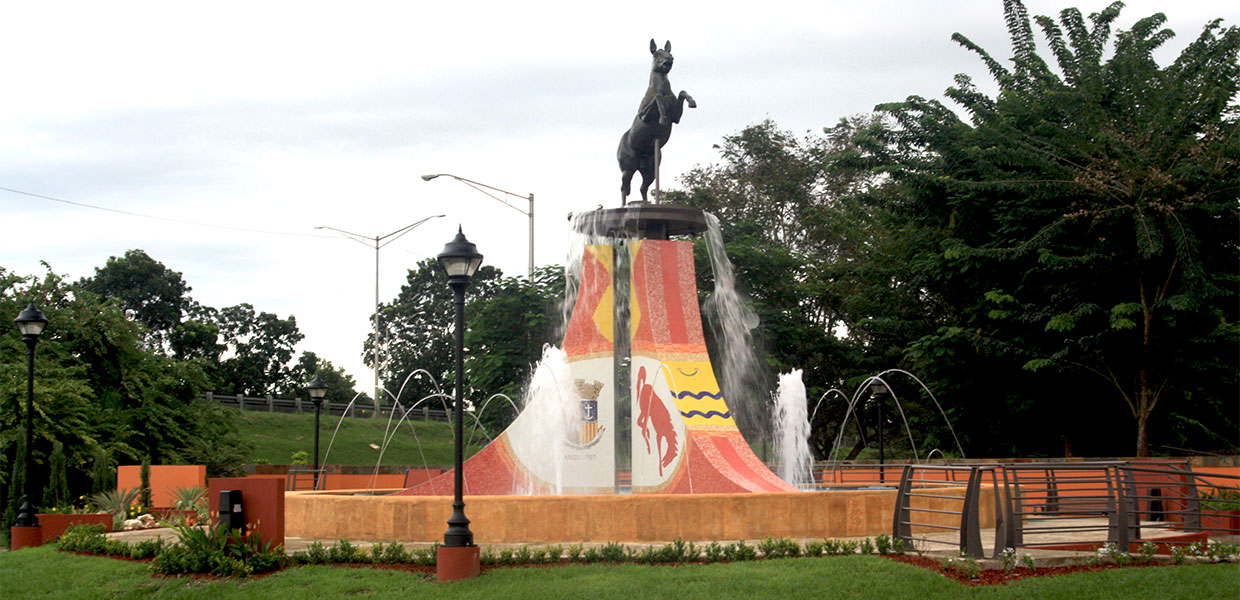
Juncos, Puerto Rico
Valenciano City
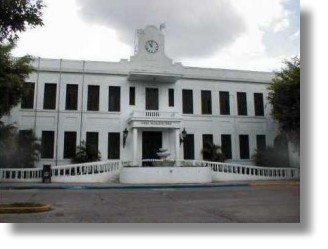
Juncos (HOON-kos) is known as the “Valencian City” and its residents are known as the “Valencian Mules.” The patron saint is the Virgin of the Immaculate Conception.
Juncos is bordered on the north by the municipality of Carolina, on the east by Las Piedras, on the south by San Lorenzo and Las Piedras and on the west by San Lorenzo. It is located in the southeastern part of the island.
Geographically, it is part of the Cayey Range region. In the north are the lower elevations of the Luquillo Range.
Today, manufacturing is the main economic activity in the municipality. Juncos has factories producing clothing, scientific instrumentation, electrical equipment and other products. During the 1970s, Juncos was an important producer of milk. Earlier, cultivation of sugar cane and tobacco were the most important economic activities in the municipality. Juncos has an important archaeological finding that was discovered in 2003 in the Ceiba Sur sector of the municipality.
Foundation:
In 1782 the inhabitants of the Juncos area requested of the secular and ecclesiastical courts the transfer of the Parochial Church that was located in Las Piedras to the Juncos area. They asked to be allowed to organize a new town separate from Humacao. The request for the formation of the new town of Juncos was accepted by the government and on August 3, 1792 the temporary governor Don Francisco Torralba issued the order for the town to be founded. Don Tomás Pagán Gracia was named the first mayor of Juncos. By request of Don Tomás Pizarro (from neighboring Las Piedras) the new town of Juncos was erected on August 2, 1797. At the time it had a parish dedicated to Nuestra Señora de la Concepción, celebrating the first mass on September 8, 1797. Later the construction of streets and a public plaza took place.
According to history, in April of that same year, Puerto Rico was attacked by the English. Several residents of Juncos in addition to 323 citizens of Arecibo and Cayey defended San Juan from the foreign attacks.
Little by little they paved streets, built a cemetery and the population grew. By 1894 the population of students was already 589 boys and 593 girls. In 1898 the town underwent many changes. At the request of the United States all citizens that occupied positions for the Spanish Government could continue to work, and those that did not want to continue could resign. Immediately afterwards the mayor Francisco Escuté resigned. On October 1 of that same year a new mayor was named, Ricardo A. Martínez. All the rest of the city council resigned. Including Claudio Calenti, José Costa, Bartolomé Palou and Miguel Mújica because they were Spanish citizens. The residents were agreeable with the appointment of Mayor Martinez and on October 13 named Agustín Collazo as the municipal sindicate (town recorder and collector of fines) and Primitivo Delfaus as the municipal accountant.
In 1912 the “Arcelay Cinema” was constructed. Nowadays this restored historical monument exists thanks to Mayor Gilberto Conde Roman (1996) where today social and cultural activities are celebrated to benefit the town. The first library was named Rosa González Toledo. In 1924 the Asociación de Beneficios Mutuos was created.
Nowadays Juncos is credited with another historical creation, the modern library in honor of José M. Gallardo who was Secretary of Education. For many years this library, which before was a school, was a testament to education for the future of the town. Juncos throughout the years, has been improving as a city for the benefit of its people, forming customs and traditions paced with the times.
Location:
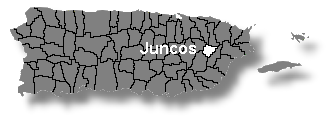 Located in the eastern central region of the island, it is bordered by: Gurabo, Carolina and Canóvanas to the north, San Lorenzo and Las Piedras to the south, Gurabo and San Lorenzo to the west, and Las Piedras to the east.
Located in the eastern central region of the island, it is bordered by: Gurabo, Carolina and Canóvanas to the north, San Lorenzo and Las Piedras to the south, Gurabo and San Lorenzo to the west, and Las Piedras to the east.
Area:
67.6 sq km / 26.0 sq mi.
Population:
36,452 (census 2000)
Population Density:
539.2 per sq km / 1,402.0 per sq mi.
People are known as:
Junqueños
Juncos is also known as:
La Cuidad del Valenciano (Valenciano City)
Los Mulos del Valenciano (Valenciano Mules*)
* Refers to a baseball team.
Wards: Juncos, Puerto Rico
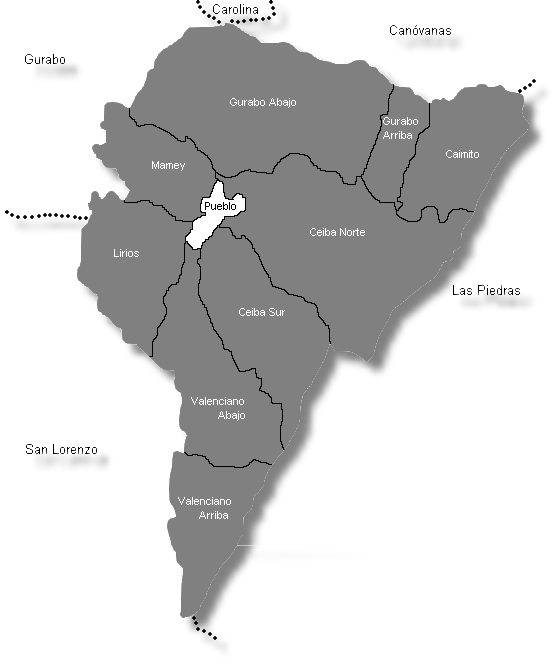
| Census 2000: Population by Wards – Juncos |
Habitants |
| Caimito | 2,658 |
| Ceiba Norte | 8,001 |
| Ceiba Sur | 4,600 |
| Gurabo Abajo | 3,731 |
| Gurabo Arriba | 589 |
| Juncos Town | 2,637 |
| Lirios | 5,499 |
| Mamey | 3,705 |
| Valenciano Abajo | 3,782 |
| Valenciano Arriba | 1,250 |
| Total | 36,452 |
Source: Censo 2000
Patron:
La Inmaculada Concepción de María
Parroquia Inmaculada Concepción
Apartado 1728
Juncos, Puerto Rico 00777
(787) 734-2431
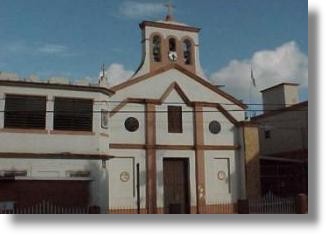
Topography:
To the north it displays lower elevations of the Luquillo Mountain Range. On the northern border the terrain rises about 700 meters above sea level. In the southern end, in the Valenciano ward, we find smaller elevations of 500 meters.
Hydrography:
The Gurabo River with its tributary the Ceiba Gorge and the Valenciano River; the Valenciano River receives waters from the Santa and Don Víctor gorges.
Economy:
Mostly manufacturing: apparrel, scientific instruments, electronic machinery and electrical equipment. In agriculture, several dairy farms produce an appreciable amount of milk.
Average Salary:
$335.84 weekly (1998)
Flag:
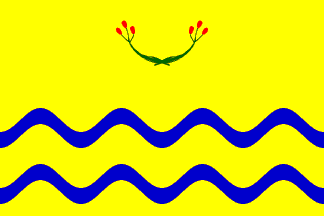 On a gold field, undulating blue stripes reside in the lower half. These represent the Valenciano River. Centered between the field and above the undulating stripes appear the reeds as they appear in the shield: yellow, blue, green and red. A resolution to accept the flag was approved August 2, 1982, by the Municipal Assembly and by Acting President Hon. Ángel Rafael Boria Gómez and Temporary Mayor Hon. Gilberto Conde Román.
On a gold field, undulating blue stripes reside in the lower half. These represent the Valenciano River. Centered between the field and above the undulating stripes appear the reeds as they appear in the shield: yellow, blue, green and red. A resolution to accept the flag was approved August 2, 1982, by the Municipal Assembly and by Acting President Hon. Ángel Rafael Boria Gómez and Temporary Mayor Hon. Gilberto Conde Román.
Coat Of Arms:
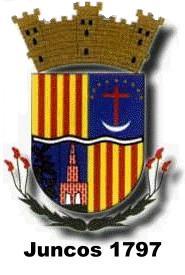 Divided into four quarters and presented to the viewpoint of the observer, the shield presents upper left and lower right vertical stripes gold (or yellow) and gules (red) in reference to the region of Valencia, Spain, and to its denomination as “Town of Valencia”.
Divided into four quarters and presented to the viewpoint of the observer, the shield presents upper left and lower right vertical stripes gold (or yellow) and gules (red) in reference to the region of Valencia, Spain, and to its denomination as “Town of Valencia”.
This reference is linked directly to the foundation of the town: during the move in the seventeenth century of the Hato Grande de los Delgado (hato or hatillo means ranch), whose territory covered the northern plains of the Central Mountain Range in the banks of the Grande de Loíza river, a series of smaller ranches appeared. One of them was called Hato del Valenciano, which years later subdivided into the Hatillo de los Lirios and the Hatillo de los Juncos. This last one developed into the village and on August 2, 1797, receiving the title of town.
The other two quarter collect the symbols of the life and the apreciation of the town. The right upper quarter presents on blue background a new moon with twelve small silver stars, symbol of the Immaculate Conception of Mary, the matron of the population. It shows also the cross, symbol of the christendom of the town.
In the lower left quarter collects the symbols of the economic history of the region. On a dark blue background a tobacco plant appears in memory of the agricultural life of the community that for many years cultivated tobacco. To the right a chimney symbolizes greatly the industrialization of the zone by sugar cane processing that also gave life in the past to this town.
The upper and lower quarters are divided by an undulating white stripe with blue edges that honors the Valenciano River, so linked to the life of this town.
Under the shield reside green reeds with red flowers in reference to the name of the town, after which the name of the town with the year of its foundation appears. The shield has a three tower crown, which is symbol of cities, villas and towns.
Places To Visit:
- Former cigar factory
- Former city hall
- Juncos Central sugar mill
- Escuté walkway
- Juncos Plaza
- Immaculate Conception Church
- Soldier’s Plaza
- Former municipal jail
- Junqueño Theater
- The Christ of Brotherhood
- Theater Cafe
Events:
- Patron Saint Festival – December
- Kite Festival – March
- Juncos Youth Festival – July
- Anniversary of Juncos – August
- Modesto Carrión International Marathon – November
- Town Festival – November
- Valenciano Carnival – November
Distinguished Citizens:
- Ramón Fortuño Sellés – Poet, writer of articles and short stories. Mayor of San Lorenzo and member of the House of Representatives.
- Rosa González Toledo – First librarian in the Island Penitentiary. Founded the Aibonito School Health Program.
- Clemente Pereda – Poet, essayist and journalist. Was the author of the book of poetry Versos de otoño (1928).
Public Schools sorted by educational levels.
Humacao Region
Juncos District
| Name | Level | Telephone | Address |
| Elementary | |||
| AGUSTÍN DUEÑO | PK-6 | (787) 734-4342 | PO Box 1721, P.R. 00777-3401 |
| ÁNGEL GONZÁLEZ | K-6 | (787) 734-8553 | PO Box 3401, P.R. 00777-2086 |
| CAMILO VALLES MATIENZO | PK, 4-6 | (787) 734-7333 | PO Box 1829, P.R. 00777-0000 |
| CARMEN ARZUAGA DE RIVERA | K-6 | (787) 734-8151 | PO Box 1823, P.R. 00777-1823 |
| FULGENCIO PIÑERO RODRÍGUEZ | K-3 | (787) 734-4733 | PO Box 1799, P.R. 00777-0000 |
| JUAN A. SÁNCHEZ | K-6 | (787) 734-4347 | PO Box 1297, P.R. 00777-0000 |
| LAURA NAVARRO | K-6 | (787) 734-4344 | PO Box 1721, P.R. 00777-0000 |
| PEDRO BOSCH | K-6 | (787) 734-4346 | PO Box 3061, P.R. 00777-3061 |
| TEODOMIRO DELFAUS | K-6 | (787) 734-4348 | PO Box 3620, P.R. 00777-3401 |
| Intermediate | |||
| ALFONSO DÍAZ LEBRÓN | 7-9 | (787) 734-6806 | PO Box 1614, P.R. 00777-0000 |
| JOSÉ A. LÓPEZ CASTRO | 7-9 | (787) 734-4544 | PO Box 31541, P.R. 00777-0000 |
| Secondary | |||
| SU CLARA M. ARAMBURU | K-9 | (787) 734-7444 | HC 1 Box 6160, P.R. 00777-0000 |
| SU PEDRO RIVERA MOLINA | K-9 | (787) 736-4148 | PO Box 1814, P.R. 00777-0000 |
| High School | |||
| ISABEL FLORES | 10-12 | (787) 734-6816 | PO Box 2107, P.R. 00777-0000 |
| JOSÉ COLLAZO COLÓN | 10-12 | (787) 734-4345 | PO Box 1268, P.R. 00777-0000 |
Himno:
Juncos Mi Bello París – By Luis Díaz Lebrón
Yo vivo tan feliz
y nunca olvidaré
el recuerdo de mi pueblo
el recuerdo de mi Juncos.
Eres pequeño París.
Juncos, tus noches
son tan bellas.
Pedacito de Tierra,
corazón de mi Borinquen.
Para ti, con el alma
te dedico esta canción.
Es tu Valenciano,
río de nácar.
Juncos, pequeño París.

